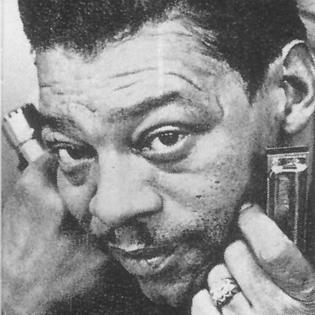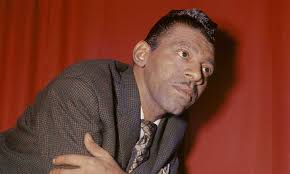The Revolutionary Harmonica of Little Walter: A Biography
Chapter 1: Introduction
Marion Walter Jacobs (1930-1968), universally known as Little Walter, stands as an undisputed titan in the annals of blues music. His name is synonymous with innovation, a revolutionary approach to the harmonica that not only redefined the instrument’s role in blues but also left an indelible mark on subsequent generations of musicians across various genres. Born in rural Louisiana, Little Walter’s journey from humble beginnings to becoming a pivotal figure in American music is a testament to his extraordinary talent and relentless pursuit of sonic exploration. His groundbreaking techniques and profound influence were formally recognized with his induction into the Rock and Roll Hall of Fame in 2008, solidifying his legacy as one of the most important and influential artists in blues history.

Chapter 2: Childhood
Marion Walter Jacobs was born on May 1, 1930, in Marksville, Louisiana. The exact year of his birth has been a subject of some historical ambiguity, with various documents showing different dates such as 1923, 1925, and 1928. These discrepancies often arose from his need to appear of legal age for contracts in his early career. However, May 1st remained a consistent part of his birthdate. He was raised in Rapides Parish, Louisiana, on a farm, where he began his musical journey at a very young age. Little Walter was largely self-taught on the harmonica, demonstrating an innate talent for the instrument. By the tender age of eight, he was already learning to play polkas and waltzes, showcasing an early versatility that would later define his blues style.
His childhood was marked by an early independence. By the age of twelve, Little Walter had made the significant decision to quit school and leave his rural home. This marked the beginning of a nomadic period where he traveled extensively, busking on the streets of major Southern cities including New Orleans, Memphis, Helena, West Helena, Arkansas, and St. Louis. During these formative years, he honed his musical skills, not only on the harmonica but also occasionally on guitar. More importantly, this period allowed him to interact with and learn from older, established bluesmen of the era, such as Sonny Boy Williamson II, Sunnyland Slim, and Honeyboy Edwards. These experiences were crucial in shaping his understanding and mastery of the blues, laying the groundwork for his future innovations.
Chapter 3: Youth
In 1946, at the age of sixteen, Little Walter arrived in Chicago, a city that would become the epicenter of his musical revolution. Initially, he found sporadic work as a guitarist, but it was his already highly developed harmonica playing that truly began to garner attention. A pivotal moment in his career, and indeed in the history of blues harmonica, came from his frustration with being overshadowed by the volume of electric guitars. To overcome this, he adopted a simple yet profoundly innovative method: he cupped a small microphone in his hands along with his harmonica and plugged it into a public address system or guitar amplifier. This allowed him to compete with the volume of any guitarist, but Little Walter didn’t stop there. Unlike other contemporary blues harp players who used amplification solely for volume, he purposely pushed his amplifiers beyond their intended technical limitations. This daring experimentation led him to explore and develop radical new timbres and sonic effects, previously unheard from a harmonica or any other instrument.
His recording career began soon after his arrival in Chicago. His first unreleased demo featured him playing guitar backing Floyd Jones. In 1947, he made his first released recordings for Bernard Abrams’ tiny Ora-Nelle label. These early recordings, like many blues harp recordings of the era, showed a strong stylistic debt to the pioneering blues harmonica player Sonny Boy Williamson I. In 1948, Little Walter joined Muddy Waters’ band, a collaboration that would become legendary. Initially, he played acoustic (unamplified) harmonica on Waters’ recordings for Chess Records. However, the first appearance of Little Walter’s amplified harmonica on record was on Waters’ “Country Boy” (Chess 1952), recorded on July 11, 1951. Even after his departure from Waters’ band in 1952, Chess continued to hire him to play on Waters’ recording sessions, resulting in his harmonica being featured on most of Waters’ classic recordings of the 1950s.
Chapter 4: Adulthood
In 1952, Little Walter made a pivotal decision to leave Muddy Waters’ band and establish his own group, The Aces. This band, already a steady presence in the Chicago blues scene backing Junior Wells, featured the formidable talents of brothers David and Louis Myers on guitars and Fred Below on drums. Under Little Walter’s leadership, and often credited as The Jukes on his records, The Aces became the vehicle for his burgeoning solo career. On May 12, 1952, he recorded under his own name for Checker Records, a subsidiary of Chess Records. The very first completed take from this debut session, an instrumental titled “Juke,” became an instant sensation, spending an unprecedented eight weeks at the top of the Billboard R&B chart. This achievement remains unique, as “Juke” is still the only harmonica instrumental ever to reach number one on that chart.
Little Walter’s commercial success during this period was remarkable. Between 1952 and 1958, he amassed fourteen top ten hits on the Billboard R&B charts, including two number one singles: “Juke” and “My Babe” in 1955. This level of mainstream success surpassed that of even his esteemed contemporaries like Muddy Waters, Howlin’ Wolf, and Sonny Boy Williamson II. His singles typically featured a vocal performance on one side and a harmonica instrumental on the other, showcasing his dual talents. His musical style was distinctly modern and up-tempo, drawing inspiration from the jazzier, swinging saxophone playing of artists like Louis Jordan, which set him apart from other blues harmonica players of the time. Over the years, the lineup of his touring and recording bands evolved, including notable musicians such as guitarists Robert “Junior” Lockwood and Luther Tucker, and drummer Odie Payne. He even occasionally featured saxophone players like the avant-garde jazz musician Albert Ayler and, on one early tour, Ray Charles.
Beyond his own recordings, Little Walter was a highly sought-after session musician, lending his distinctive harmonica sound to numerous recordings for other artists on the Chess label, including Jimmy Rogers, John Brim, and Bo Diddley. He also contributed to recordings for other labels, backing artists like Otis Rush and Robert Nighthawk. However, despite his immense musical achievements, Little Walter’s adulthood was also marked by significant personal struggles. He battled alcoholism and was known for his notoriously short temper, which frequently led to violent altercations and minor run-ins with the law. These personal issues began to take a toll on his career, leading to a decline in his fame and fortune starting in the late 1950s. Nevertheless, his international reputation remained strong enough for him to tour Europe twice, in 1964 and 1967, as part of the American Folk Blues Festival. Footage from the 1967 European tour, including performances in Copenhagen and Germany, represents the only known film of Little Walter performing, with some footage showing him singing. Despite his personal challenges and infrequent recording and touring in the 1960s, he continued to play mainly in and around Chicago, maintaining his presence in the blues scene.
Chapter 5: Major Compositions
Little Walter’s discography is a testament to his prolific output and groundbreaking artistry. Among his most significant contributions to music are his numerous compositions, many of which became hit singles and enduring blues standards. His most famous piece, and arguably his signature tune, is the instrumental “Juke.” Released in 1952, “Juke” was an unprecedented success, soaring to the top of the Billboard R&B chart and remaining there for eight weeks. Its unique distinction as the only harmonica instrumental ever to achieve a number one hit on that chart underscores its revolutionary impact and Little Walter’s unparalleled mastery of the instrument. “Juke” showcased his innovative use of amplified harmonica, demonstrating how the instrument could be a powerful lead voice, capable of complex melodies and dynamic expression.
Another cornerstone of his compositional legacy is “My Babe,” released in 1955, which also reached number one on the R&B charts. This vocal track, like many of his successful singles, often featured a vocal performance on one side and a harmonica instrumental on the flip side, highlighting his versatility as both a singer and an instrumentalist. Beyond these two chart-toppers, Little Walter’s repertoire includes a wealth of influential recordings that have shaped the sound of blues and rock music. Notable compositions and hits include the evocative “Sad Hours,” the energetic “Off the Wall,” the soulful “Can’t Hold Out Much Longer,” the poignant “Mean Old World,” the driving “Blues with a Feeling,” and the classic “Key to the Highway.” Each of these tracks, whether vocal or instrumental, further solidified his reputation as a visionary musician who pushed the boundaries of the harmonica.
His songwriting approach often involved adapting earlier blues themes or crafting original pieces that resonated with the contemporary audience. What truly set his compositions apart was his innovative use of the amplified harmonica, transforming it from a background instrument into a powerful, expressive lead voice. He explored the full sonic potential of amplification, creating a raw, distorted, and often haunting sound that became his trademark. This pioneering spirit in his compositions not only earned him commercial success but also inspired countless musicians to explore new possibilities with the harmonica, cementing his place as a true innovator in American music.
Chapter 6: Death
Little Walter’s life, marked by both extraordinary musical brilliance and personal turmoil, came to a tragic end on February 15, 1968, in Chicago, Illinois, at the young age of 37. His death followed a physical altercation at a nightclub on the South Side of Chicago, where he had been taking a break from a performance. While the injuries sustained in this particular fight were reportedly minor, they exacerbated damage he had incurred in previous violent encounters, a consequence of his struggles with alcoholism and a notoriously short temper.
He died in his sleep early the following morning at the apartment of a girlfriend, located at 209 East 54th Street in Chicago. The official cause of death, as stated on his death certificate, was coronary thrombosis, a blood clot in the heart. Due to the seemingly insignificant external injuries, police initially reported his death as being due to “unknown or natural causes,” and no external injuries were noted on the death certificate. Little Walter was laid to rest at St. Mary’s Cemetery in Evergreen Park, Illinois, on February 22, 1968. His untimely passing silenced one of the most innovative and influential voices in blues music, leaving behind a legacy that would continue to resonate for decades.
Chapter 7: Conclusion
Little Walter, born Marion Walter Jacobs, may have lived a relatively short life, but his impact on the landscape of American music is immeasurable and enduring. His revolutionary approach to the harmonica, particularly his pioneering use of amplification, transformed the instrument from a mere accompaniment to a powerful, expressive lead voice. He not only pushed the technical boundaries of the harmonica but also expanded its sonic possibilities, creating a raw, distorted, and emotionally charged sound that became his hallmark.
His legacy extends far beyond his innovative techniques. Little Walter was a prolific songwriter and a charismatic performer who achieved unprecedented commercial success for a blues harmonica player, with hits like “Juke” and “My Babe” becoming iconic standards. His influence can be heard in countless blues and rock musicians who followed, demonstrating the profound and lasting impact of his artistry. Despite the personal struggles that plagued his later years, Little Walter’s musical contributions remain a cornerstone of blues history, solidifying his place as one of the most influential and revered figures in the genre. His music continues to inspire and resonate, a testament to the enduring power of his revolutionary harmonica.

Comments are closed